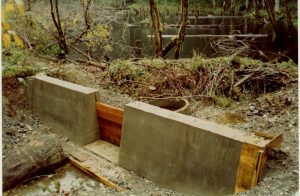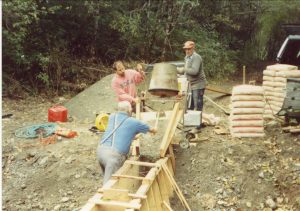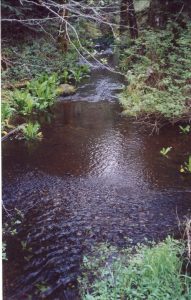Lake News, January 11, 1989
Triumph at Beaver CreeK
By Ted Burns
Leo Nelson and fellow members of the Cowichan Lake Salmonid Enhancement Society, have done much to further the cause of natural stream enhancement in Western North America. I am not aware of any other group that has succeeded in revitalizing an entire stream. The concept has received a lot of lip service but results have been spotty at best.
Prior to 1983, Beaver Creek was almost a lost cause in terms of trout and salmon habitat. Because of its small drainage area and low flushing capacity, it had matured to a condition where most of its channel was little more than mud, skunk cabbage and hardhack. It dried by May in most years and its coho run was just hanging on.
Leo Nelson lives on the edge of Beaver Creek’s little valley and is a fisherman. He saw the condition of the creek and decided to do something about it. He contacted government fisheries agencies and, after a long period of wrangling and with much support from Trevor Morris, DFO’s community advisor (an advocate for community participation in fish habitat improvement) received approval to rehabilitate the channel. The attitude of fisheries bureaucrats was “the creek’s a write-off; he can’t do any harm, so why not?” They really didn’t expect any positive results. But they didn’t know Leo.
He took a backhoe to the creek in the late summer of 1983 and cleaned out most of its channel. Tons of mud and waterlogged debris were cast aside. But that was only step one. The creek still needed summer flow. He hand built a small berm near the outlet of Beaver Lake later that year realizing that it probably wouldn’t be enough to provide summer long flow.
Returning next spring to see if any fry had resulted from his digging efforts, he found that a family of beavers had taken the opportunity to build on his work and raised the lake level over one metre. He also discovered that coho had spawned in the new channel and produced about 10,000 fry.
The basic ingredients were now in place—spawning habitat and permanent flow.
Lifted by the early results of Leo’s efforts, public and government enthusiasm has grown to the point where Beaver Creek is now the central link in a much broader effort under the umbrella of the Cowichan Lake Salmonid Enhancement Society. A small hatchery, fry salvage and colonization and continued upgrading of Beaver Creek have resulted. The Society salvages up to 300,000 trout and salmon fry from drying reaches of streams each summer and transfers thorn to suitable upstream habitat and rears 50,000 to 100,000 fry in its mini-hatchery for similar outplanting.
But Beaver Creek is still the heartbeat of their effort. Leo counted 30 spawners in 1983. 250 returned last year. Almost 600 have come back this year and Leo is still counting. His smile is ten miles wide.
The present coho commercial harvest rate is 75 per cent means about 1,800 of Leo’s were caught at sea and downstream The creek’s total production was 2400 coho. That’s amazing and certainly merits at giant smile.


